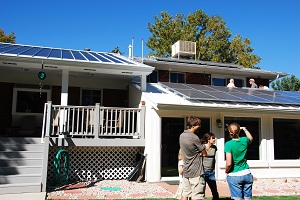Solar Feature: Colorado solar tour
 Mo and Brent Nelson raised their children in the red brick Lakewood, Colo., home where Mo, herself, grew up. Mo remembers that her mother always wanted a deck on the house. It never had one… until now.
Mo and Brent Nelson raised their children in the red brick Lakewood, Colo., home where Mo, herself, grew up. Mo remembers that her mother always wanted a deck on the house. It never had one… until now.
The deck didn’t come the way most remodeling projects do. It came as a second thought, a bonus.
“This was always about adding solar for us,” Mo said. “It was always about the solar.”
She said they’d wanted to add panels to their home but waited until their children were grown and through college to make the financial investment.
The Nelsons were one among 13 families in the greater Denver metro area who opened their homes to the public Saturday, allowing hundreds of strangers to traipse through their homes and yards to get a good look at the photovoltaic and thermal panels that made their already energy-efficient homes run.
The Colorado Renewable Energy Society sponsored the 16th annual Solar Tour, providing maps and information to people interested in renewable energy, people thinking about building their own solar-powered homes, and people who just like to spend a Saturday peeking into others’ homes and seeing how they do it.
The tour in Denver was one of more than 650 regional tours around the country, scheduled during the last week of September and the first week of October. The American Solar Energy Society lists on their website communities that are hosting solar tours along with dates, times, and contact information for local sponsoring agencies.
“Number 10 is a good house to check out if you want to see how two different technologies work,” said Joe Lenthal, a CRES volunteer who explained the $5 tour map.
Number 10 was the Nelson home.
Mo explained that her husband Brent worked for many years at the National Renewable Energy Lab in Golden, Colo., researching amorphous-Silicon panels, better known as thin film.
Because of the work Brent had done on the technology, the Nelson’s were committed to using thin film panels.
“It’s kind of like a Ford person,” Mo said. “Someone who works for Ford doesn’t go out and buy a Chevy.”
“It’s even bigger than that, though,” said Mo’s daughter Katarina, in her early 20s. “This research was a big part of his life.”
The only problem with the thin film technology is that it’s less efficient than traditional crystalline-Silicon panels, and the Nelsons needed more roof surface in order to be able to achieve their energy production goals.
That meant adding a sunroom downstairs and a big overhang that begged for a deck to be added underneath of it off of the dining room.
The Nelson’s aimed to generate 5 megawatts from solar energy. The thin film panels, while they are more aesthetically pleasing, ended up falling a bit short of that goal. With the thin film panels covering the entire roof space, they would only produce 4.7 kilowatts, Mo said.
“Using thin film was an absolute,” Mo said. “But five was the bigger absolute.”
So they added a set of traditional crystalline panels and now generate 5.7 kilowatts. They also use hydrothermal panels, which produce 80 gallons of hot water, more than enough for their domestic use.
The system has been up and running for about a year, Mo said. And she isn’t sure yet, nor does she know how to really calculate, how much energy and money they are saving because of the improvements. The kids left home at the same time, and their consumption probably fell dramatically, she said.
“But we have really enjoyed doing this,” Mo said. “Making these improvements has been a real joy.”
The Nelson home was one of four on the tour that were retrofitted with solar and energy-efficient improvements. Most of the other homes were built to generate all the power they need and sometimes more.
Pictured: Katarina Nelson shows off her parents' solar home in Golden, Colo. at the Denver solar tour Saturday. The Nelson home boasts three different types of solar panels – thin film photovoltaic (left), crystaline-Silicon photovoltaic (right), and two hydrothermal panels on the upper roof.



